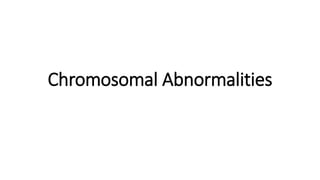This document discusses chromosomal abnormalities and provides information about chromosomes, karyotypes, and different types of chromosomal abnormalities. The main points are:
- A karyotype is an individual's complete set of chromosomes arranged in order and can be used to look for abnormalities in number or structure.
- There are two main types of chromosomal abnormalities - numerical abnormalities which involve extra or missing chromosomes, and structural abnormalities which alter a chromosome's structure through deletions, duplications, inversions, etc.
- Common chromosomal disorders that result from abnormalities include Down syndrome, Fragile X syndrome, Klinefelter syndrome, and Turner syndrome. Down syndrome is caused by an extra copy of chromosome 21 (











































